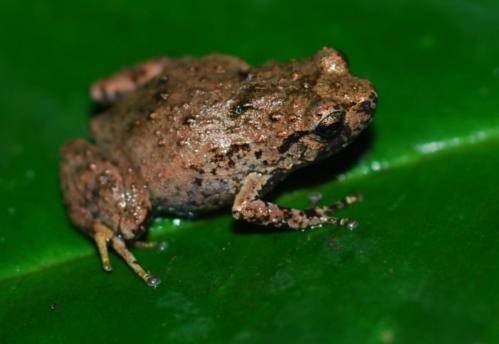| Citation |
IUCN SSC Amphibian Specialist Group 2018. Oreophryne monticola. The IUCN Red List of Threatened Species 2018: e.T57925A114919880. http://dx.doi.org/10.2305/IUCN.UK.2018-2.RLTS.T57925A114919880.en. Downloaded on 09 May 2019. |
Description |
Geographic Range
NATIVE
Extant (resident)
Indonesia (Lesser Sunda Is., Bali)
NUMBER OF LOCATIONS
2
UPPER ELEVATION LIMIT
LOWER ELEVATION LIMIT
1,000 metres
Geographic Range in detail
ESTIMATED AREA OF OCCUPANCY (AOO) (KM²)
CONTINUING DECLINE IN AREA OF OCCUPANCY (AOO)
EXTREME FLUCTUATIONS IN AREA OF OCCUPANCY (AOO)
ESTIMATED EXTENT OF OCCURRENCE (EOO) (KM²)
4499.19
CONTINUING DECLINE IN EXTENT OF OCCURRENCE (EOO)
EXTREME FLUCTUATIONS IN EXTENT OF OCCURRENCE (EOO)
CONTINUING DECLINE IN NUMBER OF LOCATIONS
EXTREME FLUCTUATIONS IN THE NUMBER OF LOCATIONS
RANGE DESCRIPTION
This species is known only from the islands of Bali and Lombok in Indonesia, between 1,100–2,300 m asl (McKay 2006). Its extent of occurrence (EOO) is 4,499 km2 and all individuals are considered to occur in two threat-defined locations.
Population
CURRENT POPULATION TREND
Decreasing
NUMBER OF MATURE INDIVIDUALS
POPULATION SEVERELY FRAGMENTED
No
CONTINUING DECLINE OF MATURE INDIVIDUALS
Population in detail
EXTREME FLUCTUATIONS
NO. OF SUBPOPULATIONS
CONTINUING DECLINE IN SUBPOPULATIONS
EXTREME FLUCTUATIONS IN SUBPOPULATIONS
ALL INDIVIDUALS IN ONE SUBPOPULATION
NO. OF INDIVIDUALS IN LARGEST SUBPOPULATION
DESCRIPTION
This species had previously not been recorded since the 1930s. It is difficult to detect due to its small size and as it is found in high elevation habitat (M. Kusrini and A. Hamidy pers. comm. May 2017), which may account for the lack of records. In three surveys between 2014-2015 on Lombok, this species was recorded in Mount Rinjani National Park (M. Kusrini pers. comm. May 2017).
Habitat and Ecology
SYSTEM
Terrestrial
HABITAT TYPE
Forest, Wetlands (inland), Artificial/Terrestrial
GENERATION LENGTH (YEARS)
CONGREGATORY
MOVEMENT PATTERNS
Not a Migrant
CONTINUING DECLINE IN AREA, EXTENT AND/OR QUALITY OF HABITAT
Yes
Habitat and Ecology in detail
HABITAT AND ECOLOGY
This species is generally known from highland forest, but has also been found in forest edges and botanical gardens on Bali (M. Kusrini and A. Hamidy pers. comm. May 2017). It presumably lays eggs on the ground and breeds by direct development without a larval stage, as its congeners.
CLASSIFICATION SCHEME
Habitats Suitability Major importance
1. Forest 1.9. Forest - Subtropical/Tropical Moist Montane Suitable
5. Wetlands (inland) 5.4. Wetlands (inland) - Bogs, Marshes, Swamps, Fens, Peatlands Suitable
14. Artificial/Terrestrial 14.4. Artificial/Terrestrial - Rural Gardens Suitable
Threats
Residential & commercial development
Housing & urban areas
Tourism & recreation areas
Human intrusions & disturbance
Recreational activities
Geological events
Volcanoes
Threats in detail
THREATS
The habitat of this species is minorly impacted by tourist activities of hiking in both Bali and Lombok (M. Kusrini and A. Hamidy pers. comm. May 2017). Volcanic activity is also a threat to this species and its habitat on Lombok (A. Hamidy and M. Kusrini pers. comm. May 2017). No large eruptions have occurred since 2010, which did destroy some small villages, however the species has been recorded since then (M. Kusrini pers. comm. May 2017). There was also a small eruption in 2016 which lasted a day, however the impact of these smaller eruptions on the species habitat is unknown (M. Kusrini pers. comm. May 2017). Human settlements and tourist infrastructure are also increasing on Lombok (Indonesian Red List Assessment Workshop May 2017).
CLASSIFICATION SCHEME
Threats Timing Stresses Scope Severity Impact score Invasive species Virus
1. Residential & commercial development 1.1. Housing & urban areas Ongoing
1. Ecosystem stresses 1.1. Ecosystem conversion
1.2. Ecosystem degradation
Low Impact: 3
1.3. Tourism & recreation areas Ongoing
1. Ecosystem stresses 1.1. Ecosystem conversion
1.2. Ecosystem degradation
Low Impact: 3
6. Human intrusions & disturbance 6.1. Recreational activities Ongoing
2. Species Stresses 2.2. Species disturbance
Low Impact: 3
10. Geological events 10.1. Volcanoes Ongoing
1. Ecosystem stresses 1.2. Ecosystem degradation
2. Species Stresses 2.1. Species mortality
|

